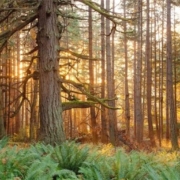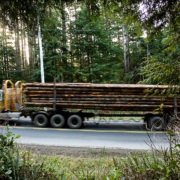Logging B.C. old-growth forests accelerates climate change: Sierra Club report
Take note that in contrast to the PR remarks of the logging companies in this article, only about 10% of the carbon is stored in long-lasting wood products after logging. The other 90% is released much more quickly through short-lived products that end up as waste in a few years.
VICTORIA — One year of logging old-growth forests in southwestern B.C. blows away a year of carbon-emissions reductions made through climate-change fighting initiatives such as the carbon tax, says a Sierra Club report released Wednesday.
The B.C. government continues to look for ways to feed more timber to struggling sawmills through proposed Forest Act changes, but the government is failing to consider the massive role intact old-growth forests play in fighting climate change, says the report, Carbon at Risk: B.C.’s Unprotected Old-growth Rainforest.
The report says logging old-growth forests on southern Vancouver Island and the Lower Mainland in 2011 — 5,700 hectares — released three million tonnes of carbon into the atmosphere, about the same amount saved through green initiatives.
It suggests old-growth forests be considered non-renewable resources and be protected from logging because it takes hundreds of years for the forests to return to their previous status as massive carbon sinks.
FORESTS STORE CARBON
Scientists cited by environmentalists say that huge, old-growth trees store massive amounts of carbon. Once they are cut down, all that carbon is released, while the resulting clear cuts store only minimal amounts.
Experts estimate it could take 300 to 500 years for the forest to return to the same carbon-storage potential.
However, a coastal forestry industry spokesman believes the report’s findings are flawed, noting scientists also agree second growth forests store carbon and new growth actually grabs hold of more carbon than old-growth forests — which are essentially, tired, old and no longer expanding.
Rick Jeffery, Coast Forest Products Association president said the Sierra Club is only interested in halting logging.
The six-page report doesn’t go that far but does make it plain that preserving old-growth forests through reductions in logging helps to store carbon.
“Avoided logging of old-growth rainforest is one of the most immediately effective actions to reduce emissions,” says the report.
“From a carbon perspective, converting old-growth rainforest to second growth is like giving away a safe, hefty bank account with a decent interest rate in exchange for a start-up bank account with almost zero money and the promise of spectacular growth based on unreliable forecasts.”
VANCOUVER IS. FORESTS UNPROTECTED
The report says about 1.5 million hectares of old-growth forest in the Vancouver Island South Coast area are unprotected, and within that area, about 600,000 hectares could be harvested.
Those forests store the equivalent of more than 800 million tonnes of carbon dioxide, more than 13 times B.C.’s annual carbon emissions.
The B.C. government’s climate-change legislation sets greenhouse-gas emissions reduction targets of 33 per cent by 2020, compared to 2007 levels. The government said it managed to reduce emissions by 4.5 per cent between 2007 and 2010.
Carbon emissions from forests are not counted as part of B.C.’s greenhouse-gas reduction targets.
Jeffery rejected the report’s findings and its calls for more protection of southern old-growth rainforests due to their carbon storage capacities.
‘THEY DON’T WANT US TO LOG’
He said the Sierra Club is using exaggerated data to support long-standing calls to stop logging in old-growth forests.
“They don’t want us to log,” said Jeffery. “That is the raison d’etre of the environmental groups. For them to tell you anything else is an outright lie.”
Jeffery said he agreed that forests store carbon but disagrees that, once old-growth trees are cut, they release massive amounts of carbon dioxide into the atmosphere.
Products from trees, such as houses and furniture, end up storing carbon, and scientific research indicates that second-growth forests also act as carbon-storage sources.
“They’re basically telling you that once you cut that old-growth tree, that carbon all gets released into the environment,” said Jeffery.
“It goes to other uses. It gets recycled. It goes into buildings and it gets stored.”
Sierra Club spokesman Jens Wieting said forest policy debates are focused on increasing timber supplies for forest companies while ignoring the ever-increasing carbon emissions attributed to increased logging of old-growth forests.
“The emissions from B.C.’s forests today are higher than our official emissions from fossil fuels, primarily burning fossil fuels, and nobody’s talking about it,” said Wieting.
“There’s forest policy in place and discussions about making changes to the Forest Act without addressing carbon.”
FORESTS MINISTER PROMISES ‘OLD-GROWTH PROTECTION’
Forests Minister Steve Thomson said B.C. is a world leader when it comes to protecting old-growth forests and introducing environmental policies. He did not directly address carbon emissions and their relation to logging in old-growth forests.
“There’s always concerns around old-growth areas,” Thomson said. “That’s why we need to make sure we have the old-growth protection in place.”
The Liberals introduced amendments last week to the Forest Act that propose to convert volume-based tree farm licences to ones that are area-based.
Independent MLA Bob Simpson said he intends to mount a challenge to the amendments on the grounds that the move from volume to area licences is simply a proposal designed to appease U.S.-based forest company Hampton Affiliates, which called for a guaranteed timber supply following last year’s explosion that destroyed its Burns Lake mill and killed two workers.
Simpson said the amendments will hurt other area mills because they will reduce their timber supply.
He said the government would be better served amending the Forest Act to offer better ways of protecting and measuring the remaining old-growth forests.
“B.C. does have a problem where they need a forest strategy that addresses the issue that our forests are a massive source of carbon and we kind of hide that,” Simpson said.










